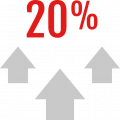The Top 6 Dental Embezzlement Red Flags
All about Embezzlement Red Flags
First, let’s begin with a summary of the key points:
- An “embezzlement red flag” is an indicator of a circumstance that varies from “normal”. It shows that something is out of the ordinary and may need to be investigated further.
- An embezzlement red flag is simply a warning sign. A probability that the red flag is correlated with employee dishonesty.
- Red flags are not evidence that theft has occurred.
Dentists can encounter two distinct categories of red flags within their dental practice.
- Behavioral Red Flags: identified by observing employee behaviors that are correlated with embezzlement
- Statistical Red Flags: unexplained discrepancies or variations in billing, payments and deposits over time.
How can I check my dental practice for red flags?
If you search the internet for the words “embezzlement red flags”, you’ll find dozens of articles and online resources dealing with the subject.
Most of the online red flag assessments I have viewed ask questions that require a binary Yes or No answer.
Here are a few of the red flag questions being asked:
- Does your employee have a wheeler-dealer attitude?
- Does your employee appear to have financial difficulties?
- Is your employee resistant to change or territorial?
These questions pose a problem, as they force you to choose between two options – either a yes or a no.
A better solution is ask questions that allow for responses of Yes, No, Uncertain, and Does Not Apply.
A well designed embezzlement red flag questionnaire have such questions.
Most embezzlement risk assessments, including my own will assign a point value to each response and calculate a total score at the end.
This is a good idea, but only when the scoring mechanism is understood, and scores are for self-assessment.
Recently, I came across an embezzlement risk assessment questionnaire that once completed, predicted your risk of embezzlement in these four categories. Scary answers indeed!
- Embezzlement is unlikely, but still may happen.
- Perhaps embezzlement is happening.
- There is a good chance embezzlement is happening.
- Almost certain embezzlement is happening.
The questionnaire included a “24 hour emergency hotline” to call if you need help. Just be sure to have your credit card handy when you call.
Consider this statement:

Fraud experts say that in 40% of embezzlement cases reported, the person stealing displayed a living standard disproportionate to their income.
This is how I like to think of it.
Let’s say you are convinced your employee “living beyond their means” and you are unable to find a reasonable explanation to account it; then there is a 40% chance that your employee’s enhanced lifestyle is the result of them stealing from you.
CONSIDER THIS NEXT STATEMENT

Fraud experts also report that in 20% of embezzlement cases, the perpetrator displayed “control issues”, or an unwillingness to share duties.
If you have a employee like this, then there is a 20% chance that your employee’s control freakishness is driven by behavior is a result the employee’s desire to “keep control” of things like the practice software and practice accounting for fear that you may uncover the theft.
Conversely, there’s an 80% chance that the employee’s behavior is linked to something else. Perhaps the employee is naturally OCD (like me) or trying to conceal their sloppy work that if discovered, would reflect poorly on their job performance.
Here are The TOP 6 Dental Embezzlement Red-Flags
At least one TOP 6 red flag was found in 85% of dental embezzlement cases.

Here are the most common red flags ranked by percentage of embezzlement cases each red flag was observed.
Pay attention to the TOP 6.
- Living beyond means – 40% of cases
- Financial difficulties – 34% of cases
- Wheeler-dealer attitude – 20% of cases
- Control issues, unwillingness to share duties – 19% of cases
- Divorce/family problems – 17% of cases
- Suspiciousness, irritability, or defensiveness – 14% of cases
- Addiction problems – 13%
- Past legal problems – 9%
- Past employment-related problems – 8%
- Complaining about inadequate pay – 7%
- Refusal to take vacations – 7%
- Instability in life circumstances – 5%
NEED HELP REMEMBERING TOP SIX?
If “Two Zebras Bit My Cookie” helped you remember the facial nerves, then “Looking For Ways to Catch Dishonest Suspects” can help you remember the TOP SIX RED FLAGS.
“Looking For Ways to Catch Dishonest Suspects“
L-F-W-C-D-S
L – living beyond means
F – financial problems
W – wheeler-dealer
C – control issues
D – divorce/family
S – suspiciousness / irritability
CAN I check MY Practice for Embezzlement Red-Flags?
Yes, you can take our dental embezzlement self-assessment. Your responses are anonymous.
To learn more, click the button below.
What SHOULD I DO IF THERE IS A red-flag in my practice?
Remember – a red-flag is an indicator that fraud may be present; but it does not guarantee its presence. There may be an innocent explanation, but it may also point toward something more sinister.
Do not ignore a red flag. The rule is – every red flag must be reasonably explained – follow the steps below:
Step 1: APPLY Skepticism

This is where you apply reason, logic and common sense.
Do not jump to conclusions.
(1) For each red flag that you observe, consider if there might be an alternate explanation, and the plausibility of that explanation being valid.
For example: if your employee is clearly “living beyond their means” and her explanation is “I had big win at the casino” – then more likely to be a lie.
However, if you are aware that your employee recently received an inheritance or recently met a new partner with a solid W2, then that explaination is less likely to be a lie.
(2) When asked to assess a red-flag, consider the question and the “weight” of your response.
Example: two dentists answered YES to this red-flag question:
Question: “Does your employee have financial pressures at home?”
Dentist 1 answered yes based on the fact that the employee’s wages were recently garnished (or creditors were calling the practice, or practice loans were not repaid, etc.)
Dentist 2 answered yes after overhearing the employee complaining to a co-worker about “how hard it is to make ends meet these days.”
Both dentists subjectively answered YES, however my intuition tells me that Dentist 1 should probably be more concerned than Dentist 2. (gambling is another red flag)
Step 2: CONDUCT A QUIET Inquiry
If careful reasoning cannot explain the red-flag you observed, then the next step is to conduct a quiet inquiry.
Ask yourself if other sources of information can be used to corroborate what you observed?
For example: If you are concerned that your employee is the first to arrive or last to leave the each day (or comes in after hours to do work), then you can inquire further by checking your building alarm system and computer audit logs.
Most practices have an alarm system to that must be disabled when you enter, and enabled when you leave. Checking your building alarm log can tell you “how early” and “how late” your employee was coming and going.
Some employees will have a legitimate reason for coming to work early or staying behind. It could be that they started to use public transportation, or ride share to work with a friend who has to be at their job earlier – so your emoloyee is dropped off at work earlier.
In situations like this, the employee will have a predictable pattern.
For example, If your employee uses public transportation or shares a ride to work, they will “arrive early” at work around the same each day.
If an employee is coming in early because they need to “do things” in order to conceal embezzlement from you, then pattern will vary. Some days the employee may not come in early, other days the employee will come in really early.
Your alarm logs will also show if someone goes into the office after hours or on weekends.
If your alarm log shows your employee came in on Saturday night; check to see how long the employee was in the practice. If the employee stayed only for a few minutes, then likely they came by the office to pick something up that they left behind (like a wallet or cell phone).
If the employee stayed for an extended period of time, more than 10-15 mins, then it is more likely that they are up to no good.
You can also run an “audit report” from your practice management software to look for events that occur outside normal business hours. Most practice management software audit reports will show the date and time of events. Using those timestamps, look to see if things were happening when the office should have been closed.
If your own inquiry does not, or cannot remove your concerns, then consider the next step.
Step 3: CONSIDER A Diagnostic Examination
If you are unable to confirm a reasonable explanation for the red-flags or your suspicions remain strong, then a diagnostic examination of your practice’s computer data and business records to look for and identify evidence of embezzlement may be indicated.
If embezzlement is uncovered, the diagnostic examination will then estimate its scope and scale, so the practice owner can make informed (and important) decisions regarding recovery, restitution and possible prosecution.
As well, the diagnostic examination generally can provide the evidence required to terminate the perpetrator’s employment on a “for cause” basis, if they are still employed by the practice when the discovery is made.
Contact
William Hiltz BSc MBA CET

Hiltz & Associates
and the creator of
Dental FraudBusters.


